Pricing is the most important strategic aspect of a SaaS product. Growing software companies have to strike a fine balance between maximising user numbers and revenue but there’s often a discord between these two goals.
Free tools often steal the headlines with huge growth rates but they famously struggle to generate revenue. And, as we’ll see later on in this article, software buyers generally don’t go for the cheapest option available to them.
In this guide, we look at the most important pricing strategies and models for SaaS companies, plus some psychological hacks you can use to win more customers and sign them up to more profitable plans.
What are we looking at in this article?
This article is broken down into the following five sections and you can click on the links below to navigate to each part of this guide:
- Pricing models vs strategies: In this section, we break down the difference between pricing models & pricing strategies to make sure the terminology in this article is 100% clear.
- Pricing model examples: We look at some of the most common (and not-so-common) SaaS pricing models.
- Pricing strategy examples: We examine different pricing strategies and the merits of each approach.
- Psychological hacks: Techniques you can use to influence the perception of value vs cost, increase sales and encourage prospects to choose more expensive plans.
- How to choose the right pricing strategy: Finally, we explain how you can determine the ideal pricing strategy for your SaaS company.
After a quick clarification of the difference between pricing models and pricing strategies, we dive into the most important pricing models used by SaaS companies – with examples – and explore the pros and cons of each one.
Then, we take a look at the broader pricing strategies SaaS companies adopt at the business and marketing level, which informs the decisions you make with pricing models and so much more.
Finally, we explore some of the most powerful psychological hacks that you can use to influence the perception of value about your offer and discuss the process for choosing the right pricing strategy for your SaaS product.
Pricing models vs pricing strategies
First up, let’s make sure we’re all clear on the terminology being used in this article because pricing models and pricing strategies shouldn’t be used interchangeably.
- Pricing model: This is the pricing model that explains how customers are charged for your software, based on their usage – all of which should be visible on your pricing page.
- Pricing strategy: This is the internal pricing strategy of your company, devised with short, mid and long-term goals in mind.
Obviously, the pricing model is an integral part of any pricing strategy but it’s important to distinguish the difference between the two. And, in the context of this article, we’re looking at pricing models as the visible explanation of how users pay for your product, what they get in return for their money and the perceived value this creates.
You could say we’re looking at pricing models as a conversion rate optimisation strategy to maximise paid users and the broader pricing strategy to hit revenue targets.
SaaS pricing model examples
In this first section, we take a look at the most common SaaS pricing models and explain the pros and cons of each one. We’re looking at seven models in particular and you can click the blue links below to navigate directly to them:
- The flat-rate model: A simple policy of charging one fee for one product without any plans of feature variations.
- The tiered pricing model: Multiple tiered plans at different price points based on features, usage or other factors.
- The freemium model: Providing a free version or plan that works as a standalone product with paid upgrade options (usually used as part of a tiered model).
- The feature-based pricing model: A tiered system where plans are priced on feature availability.
- The usage-based model: A tiered system where plans are priced on quantifiable usage – e.g.: storage space, database size, messages, etc.
- The pay-per-user model: A system where fees are charged based on the number of user accounts required.
- The pay-as-you-grow model: A B2B SaaS pricing model that promotes plans for different businesses sizes and encourages customers to upgrade as they grow.
- The one-time fee model: A policy that requires users to pay one up-front fee for lifetime usage – normally for the latest version of a product without updates.
Modern SaaS companies use a mix of these pricing models, most commonly worked into a tiered system where plans are priced on features, usage and user numbers, for example.
So it’s not like you have to choose one of these models in isolation – except, perhaps, if you go for the flat or one-time fee models (you can always include these as optional, of course).
Anyway, let’s get started with our first pricing model.
The flat-rate model
Flat-rate pricing isn’t so common these days and it kind of went out of fashion along with software licensing when cloud computing changed the whole software game.
Unlike the old licensing models, flat-rate pricing lends itself well to the monthly fee strategy that’s synonymous with SaaS.
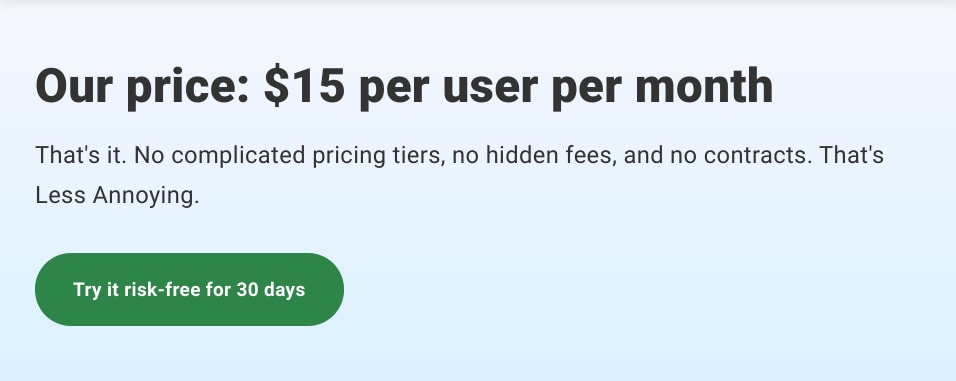
It’s difficult to find examples of the flat-rate model in action as tried pricing has firmly become the norm in the industry. However, some companies are turning back to flat-rate pricing as a unique selling point, which can appeal to buyers who are tired of the complex pricing plans typical of most SaaS products.
Pros of flat-rate pricing
- Simplicity: Flat-rate pricing makes it easy for prospects to understand your offer and make a purchase decision.
- Clarity: It also makes life easier for your marketing and sales teams when it comes to communicating the capabilities of the product without breaking everything down into plans.
- Differentiation: With most SaaS companies offering plans at different price points, the flat-rate model is a chance to differentiate your offer.
The cons of flat-rate pricing
- Limited market: With flat-rate pricing, you have to choose one price point, meaning you can’t target smaller and larger businesses.
- Lower revenue potential: As a result, your total revenue potential is lower than models allowing you to target every business size.
- One-shot marketing: With one product and one offer, you only get one shot at convincing potential customers without any room for leeway on pricing and capabilities.
- Limited satisfaction: The single product, flat-fee approach also limits your ability to satisfy diverse needs with plans designed for different business types and budgets.
- No upgrade path: With one plan, there’s no upgrade path for customers to navigate as their needs become more advanced.
- No upselling: You also have no opportunity to upsell customers on to more expensive plans.
The flat-rate model is a respectable pricing strategy that keeps things simple for the end user. If you have a very specific target audience, they might appreciate this simplicity and the flat-rate model may even help you stand out among other providers using more complex pricing strategies.
However, the flat-rate model isn’t suitable for SaaS companies looking to maximise revenue by targeting different businesses sizes and retaining customers as their needs become more advanced.
This is why the tiered pricing model has become so widespread.
The tiered pricing model
Most SaaS companies operate with a tiered pricing model of some kind with multiple plans at different price points. This overcomes the limitations we discussed with flat-rate pricing where you have to target a limited range of companies.
The tiered model allows you to target businesses of all sizes and varying needs with prices differentiated on features, usage, user numbers, services or whatever criteria makes sense for your product.
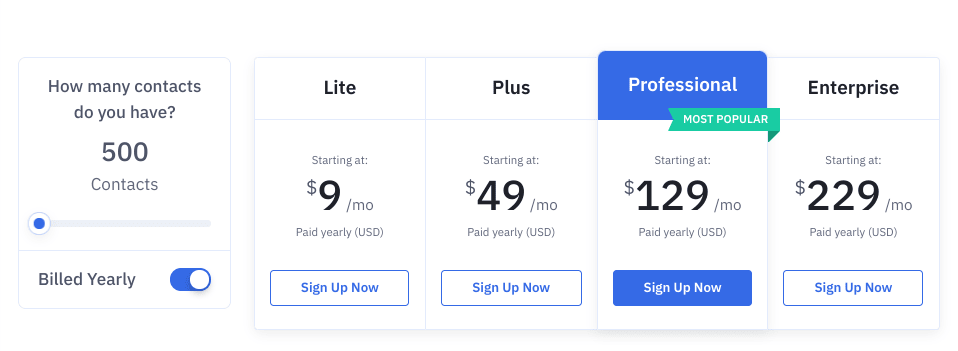
For example, ActiveCampaign offers four different plans for businesses of different sizes, offering a more advanced set of features on each plan. The company also varies the pricing of each plan based on the number of contacts customers store on the system, which combines two models we’re going to look at later: feature-based pricing and usage-based pricing.
Most of the pricing models we’re looking at in this section are variations of this tiered structure and, as ActiveCampaign does above, it’s common for SaaS companies to mix and combine different models into a multi-plan format.
Pros of tiered pricing
- Market reach: A tiered pricing model allows you to multiple target personas and businesses of all sizes.
- Growth potential: By targeting more of the market, you have more opportunity for growth.
- Increased revenue potential: By targeting a wider pool of businesses, your revenue potential multiplies.
- Diversified income: You can create a steady income from small business customers while targeting bigger wins with enterprise contracts.
- Clear upgrade path: Prospects can see the upgrade path ahead of them before they sign up.
- Upselling opportunities: Tiered pricing gives you a platform to upsell customers to more expensive plans and increase customer value.
- Engagement / retention: By excluding features, usage or access on lower plans, you can increase engagement and incentive with motivation to upgrade to the next plan.
The cons of tiered pricing
- Complexity: Complex pricing isn’t ideal for the end customer and it may put some prospects off altogether.
- Choice overload: Providing prospects with too many options to consider can trigger a cognitive impairment known as choice overload (or overchoice) which often results in choice deferral – where users refuse to make a decision at all.
- Strategic complexity: Deciding how to differentiate plans (features, usage, etc.) and price each one is a long-term challenge.
- Optimisation: You’re not going to come up with the perfect tiered pricing model first time around – you need to test variations to find the ideal compromise for your target audiences.
- Unhappy campers: No matter how you structure your tiered pricing model, some customers are going to complain about having to upgrade for X, pay for Y or not get Z on their existing plan.
The tiered pricing model is the norm for SaaS companies for good reason: it allows you to target as much of the market as possible and diversify income from customers of different sizes and budgets.
This is crucial for today’s modern breed of SaaS companies looking to maximise growth with a balance of small business and enterprise customers.
The tiered pricing model also paves an upgrade path that helps SaaS companies increase customer value with upselling campaigns and incentivising upgrades by always promising that extra bit more – a tactic that’s especially effective for B2B SaaS products.
The freemium model
Freemium pricing took the SaaS world by storm thanks to the successes of pioneers like Dropbox, Slack, Evernote and HootSuite.
The strategy involves offering a limited free version of a software product alongside a premium version or multiple paid versions. The aim is to maximise sign-ups to the free version, as a growth strategy, and premium sign-ups, to generate revenue, while upselling as many free users to paid plans as possible.
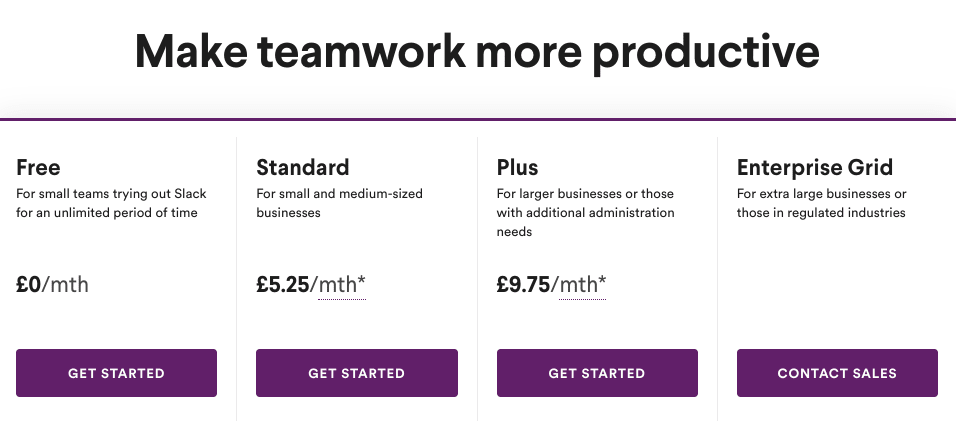
Pioneers like Dropbox and Slack used the freemium model to drive huge growth numbers and attract venture capital. They prioritised rapid growth, branding and market dominance over profits and the strategy paid off, as long as they were able to secure that next round of funding.
The freemium model gradually lost popularity through the late-2010s as the list of failed startups mounted and revelations emerged that companies like Slack were losing money, not making it. The hype around freemium SaaS startups faded and investors now place more pressure on companies to prove they’re capable of turning a profit.
However, the freemium model is making a bit of a comeback – not as the latest growth hacking trend but a legitimate SaaS pricing model that can capture valuable leads with a viable upgrade path.
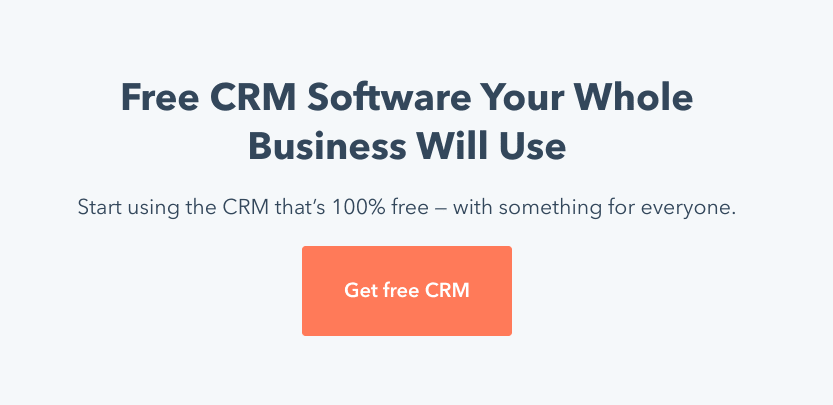
For example, HubSpot is undoubtedly a premium software provider but it offers free versions of most of its products and one of the best CRMs in the game on a free-forever basis.
This company isn’t really interested in free users, though. HubSpot is targeting companies willing to spend tens of thousands every year (or every month) on its marketing software and the free versions are there to maximise lead generation and fuel its upselling strategy.
At the lower end of the market, EngageBay also offers a free version of its all-in-one marketing and sales CRM with a similar strategy in mind.
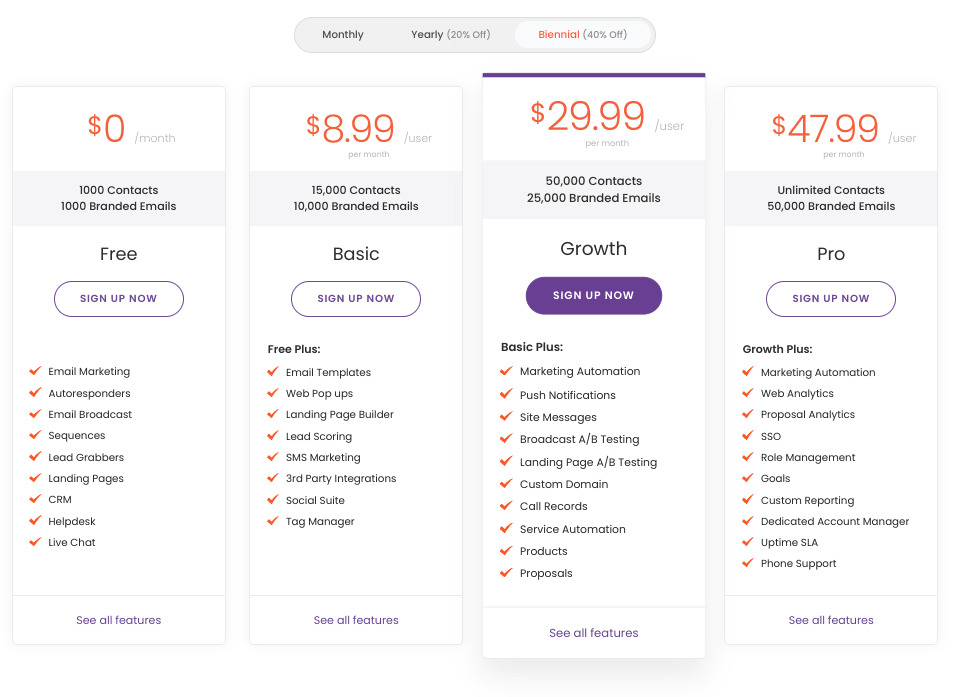
By placing heavy usage restrictions (e.g.: 1,000 contacts) on the free plan, the company aims to maximise lead generation with the free plan and turn as many of these users into paying customers as possible.
While freemium models of the past have often prioritised growth over profits, SaaS companies are increasingly using this pricing model as a lead generation strategy with clear revenue targets in mind.
Pros of freemium pricing
- User growth: The freemium model is effective if user numbers is a key growth metric to your business strategy.
- Audience reach: A quality free plan or product gives a wider pool of people reason to talk about your software and recommend it to others.
- Hype marketing: Free SaaS products can generate a lot of hype if they deliver real value.
- Data capture: A larger pool of users gives you access to more valuable data, which you can either monetise or use to optimise your own product.
The cons of freemium pricing
- Revenue: Making the freemium model profitable can be difficult.
- Cost: Free users are expensive – you invest in capturing, managing and nurturing them and, in most cases, get nothing in return.
- Upselling: Free users are typically the most difficult to upsell and you’re looking at a longer, more expensive lead nurturing path.
- Churn rate: Free users are also the most likely to churn.
- Value perception: Offering a free plan or version can lower the perceived value of your product, including the paid versions and how much you can charge for them.
The freemium model shot to fame with companies like Dropbox and became the hottest trend in SaaS pricing for many years. However, it’s a difficult model to pull off and it’s better suited to some products than others.
For example, if your aim is to dominate the market with a simple, affordable product (something like Dropbox, Slack or Zapier), then the freemium model can help you build the hype and user numbers you need while maintaining an affordable upgrade path to nurture users into paying customers.
Let’s remember Slack didn’t even make this model profitable but used it to build a $27.7bn brand evaluation before going public – whatever works, right?
By this point, I should say the freemium model isn’t suitable for more expensive SaaS products or companies that want to nurture the majority of their users into paying customers. However, as we’ve seen from HubSpot and EngagageBay, companies are successfully adapting the freemium model into a viable upselling strategy.
Clearly, the freemium model can work with the right strategy but make sure you understand its intricacies before you dive in.
The feature-based pricing model
The feature-based pricing model is the most common application of the tiered model where plans are separated and priced as the feature list becomes more advanced, as seen in this screenshot from the pricing page of Zoho’s CRM:
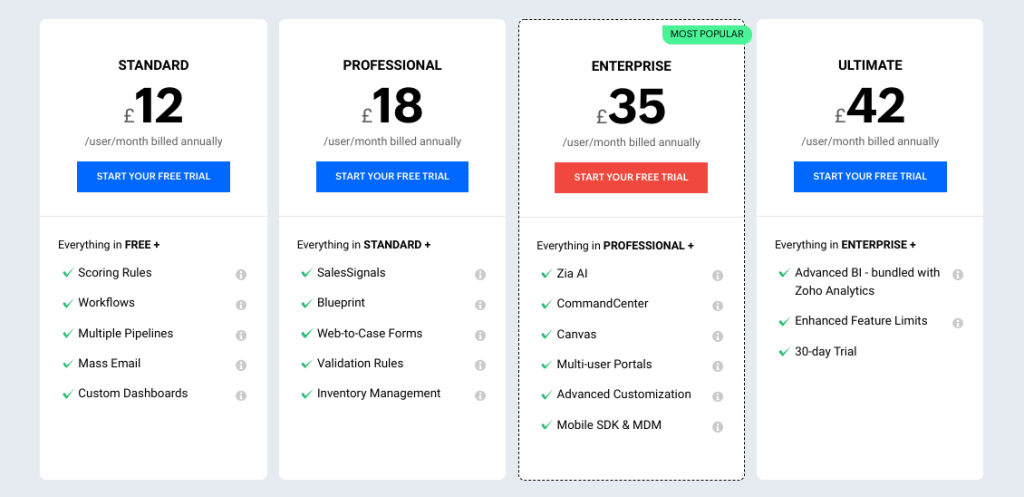
As users upgrade, they get access to more capable features and there’s a clear upgrade path set out ahead of them. This can be especially effective for B2B SaaS products where advanced features promise improved business performance or productivity – the key is convincing prospects that upgrading basically pays for itself in terms of business value.
That’s not to say feature-based pricing doesn’t work for consumer SaaS products but you may have to work a little harder to communicate the value of features or work up desire.
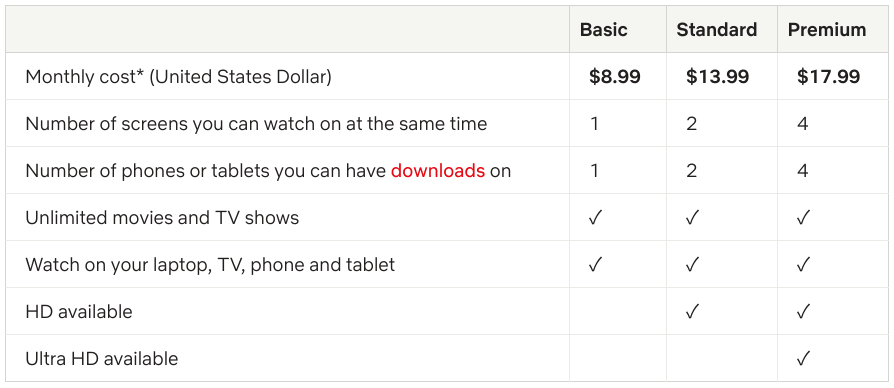
For example, Netflix’s Premium plan allows users to watch content on more screens, download to more devices and access Ultra HD content. While B2B companies can position advanced features as money-makers, Netflix relies on the perceived user benefits of its advanced features alone.
This might appeal to families or 4K TV owners with blistering internet connections but, aside from that, everyone gets access to the same stuff on each plan.
Pros of feature-based pricing
- Coverage: By dividing features across plans, you can cater to different audiences with different needs (e.g.: small and enterprise businesses).
- Clear upgrade path: You can set out a clear, easy-to-understand upgrade path that users can browse and compare on your pricing page.
- Strong upgrade incentive: With strategic feature division, you can create a strong incentive to upgrade as your customers’ needs become more demanding.
- Upselling: A clear upgrade path and strong incentive lay solid foundations for your upselling strategy to increase customers value.
- Deliverability: Some features cost more to deliver and feature-based pricing allows you to ensure the ROI is always there.
- Value perception: By placing features on higher-tier plans, you communicate to prospects that they’re more valuable.
The cons of feature-based pricing
- Complexity: Dividing plans by features creates a more complex pricing structure, which can add friction.
- Choice overload: Providing prospects with too many options to consider can trigger a cognitive impairment known as choice overload (or overchoice) which often results in choice deferral – where users refuse to make a decision at all.
- Strategic complexity: Deciding how to divide features and price each plan is a long-term challenge.
- Optimisation: You have to invest time and money into optimising plans and pricing to find the best balance for the majority of your target customers.
Feature-based pricing is the most common model used by SaaS companies because it provides coverage for different target customer groups while communicating the difference of each plan in a clear, comparable way.
The usage-based model
Another common model that’s often worked into tiered pricing and feature-based pricing is the usage-based pricing model. This involves charging customers on the grounds of how much or often they use features, tools or resources.
For example, earlier, we looked at how ActiveCampaign charges for features and the number of contacts customers store on its CRM.
Likewise, if we look at the pricing page for Unbounce, you can see plans are priced on the number of monthly conversions, page visits and the number of domains connected to the account.
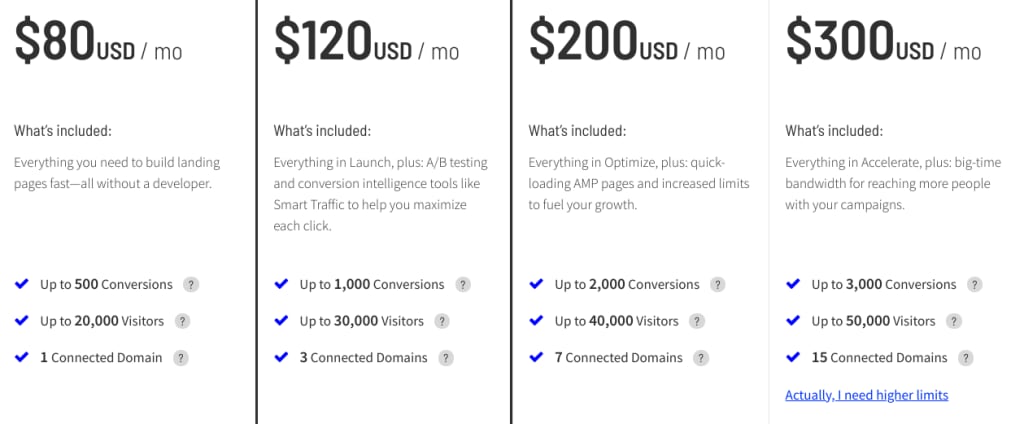
There are some feature restrictions on the cheaper plans but all plans allow users to create unlimited landing pages, pop-ups and sticky bars with pricing primarily focused on visitor numbers and conversions.
Here, Unbounce is pricing its plans based on two of the most important KPIs for landing page campaigns: traffic volume and conversions. More traffic generally means more conversions and more conversions should drive more revenue so, instead of simply pricing around features, Unbounce pinpoints the highest-value aspect of its platform.
This is a good approach for B2B SaaS products designed to scale with growing businesses, on the basis that your product helps companies grow and generate more revenue before they need to upgrade and invest more in further growth.
We’ll explore this concept in more detail later when we discuss the pay-as-you-grow model, which combines many of the concepts we’ve already looked at.
Pros of usage-based pricing
- Simplicity: Usage-based pricing is normally easier to explain, understand and compare than feature-based pricing.
- Feature parity: You can give every customer access to all or most of your features.
- Coverage: Like most tiered pricing models, the usage-based approach opens coverage for multiple prospect groups and businesses sizes.
- Scalability: Usage-based pricing makes it easy to create scalable plans that grow with your customers.
- Clear upgrade path: This model typically lays out the clearest upgrade path.
- Justification: Usage-based pricing tends to be the easiest model for justifying with customers – as long as you’re not too stingy with your limitations.
- Covers heavy users: This pricing model is important if heavy users cost you a lot of money.
The cons of usage-based pricing
- Low value perception: Strict usage-based pricing can reduce the value perception of features or the key benefits of the product.
- Low upgrade incentive: Users can feel unsatisfied with having to pay more for the same features they already have access to.
- Churn rate: Lower upgrade incentive normally goes hand-in-hand with higher churn rates.
- Unpredictable revenue: Usage-based pricing can make it more difficult to predict revenue, especially if customers are moving between plans on a month-to-month basis.
- Business size disparity: Heavy small business users can end up paying more than light enterprise customers.
- Price hikes: Usage-based pricing can lead to customers getting hit with sudden price hikes, which doesn’t always go down too well.
In reality, usage-based pricing isn’t a model to use in isolation because it removes value perception from features and compromises upgrade incentive, which are both crucial for SaaS products.
Even in the case of Unbounce, which prioritises usage-based pricing, the company still integrates it with feature-based pricing, limiting A/B testing, AMP landing pages and several other features for higher-tier plans.

It’s more common to see SaaS companies prioritise feature-based pricing and include usage limits on certain features or tools, as we saw with ActiveCampaign, earlier.
For example, Salesmate mainly differentiates plans on the features available for different businesses sizes but there are usage limitations on each plan for things like the number of emails customers can send, the number of automation workflows they can use and the storage space available.

This is a good tactic if certain features are expensive to deliver for heavy users, such as secure storage space or you identify high-value features where a pay-per-use system makes sense – like Unbounce’s approach to charging for conversions.
The pay-per-user model
The pay-per-user model is extremely common in SaaS pricing, second only to feature-based pricing. If we take another look at the pricing page for Zoho’s CRM, you’ll find a slither of pricing small print that’s on the vast majority of today’s SaaS pricing pages:

As you can see, these plans are priced per user, per month (but paid annually), which means those affordable price tags become significantly more expensive for companies with larger teams.
The upgrade path can also work out pretty expensive, too, as companies aren’t only bumping up to more expensive plans but the fees are multiples with every new team member that needs an account.
This isn’t necessarily an issue for something like accounting software where teams tend to be small (or even one-person) but it’s a big deal for something like collaboration, sales or marketing software designed for full teams.
The key benefit of this pricing model is that SaaS companies can generate revenue from customers based on usage and growth, hopefully earning more money from each client over time.
Another important benefit is that it covers you for usage so large teams hogging up server juice and storage space are paying fairly for it.
However, the downside is that you incentivise customers to not increase account numbers, which creates a growth barrier, reduces daily user numbers, limits your ability to capture user data and makes your tests less reliable.
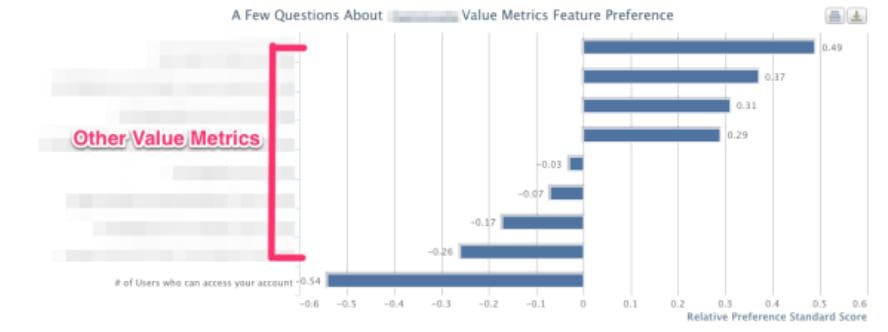
As Patrick Campbell warns in this article for Price Intelligently, per-user pricing can damage your growth prospects. Aside from de-incentivising customers, the company’s research finds that user accounts are the least valued “feature,” which means you’re pricing around something customers and prospects see little value in.
Compare this to the Unbounce example we looked at earlier, where the company bases prices on the number of conversions customers generate from its landing pages – a key revenue driver for companies using the software.
Pros of pay-per-user pricing
- Customer value: Per-user pricing multiplies revenue from customers as their teams grow.
- Growth-alignment: Team size typically correlates with business growth so you could position this as a kind of “pay-as-you-grow” model.
- Usage: Per-user pricing covers the cost of customers with large teams, which are more expensive to take care of.
The cons of pay-per-user pricing
- Low value perception: User accounts don’t correlate with profit, revenue or business value.
- De-incentivisation: Per-user pricing de-incentivises customers to create more user accounts.
- Expense: This model works out as very expensive for larger teams, even if the listed prices appear affordable.
- Coverage: As a result, your product is unlikely to attract enterprise customers or companies with larger teams.
- Churn: Per-user pricing creates an expensive upgrade path for growing companies, which leads to higher churn rates.
- Growth barrier: By discouraging account creation and pricing out larger teams, per-user pricing can limit your growth potential.
Per-user pricing is a great way to ensure you generate enough ROI from customers with large, expensive teams. However, from the customer’s perspective, this pricing model only comes with problems.
Above all, user accounts have no relation to profit, revenue or any business value that you can use as a selling point to price plans – and this is a big problem. Unless you can position this as a kind of “pay-as-you-grow” model or find another way to place value on user accounts, this is a difficult sell.
The other big problem is that user-based pricing places all kinds of barriers in the way of growth. You discourage account creation and create an expensive upgrade path that could actually force customers to leave instead of paying more for the same software they’ve already been using.
The pay-as-you-grow model
The pay-as-you-grow tactic is more of a value proposition than an actual pricing model. The reason I say this is because it typically adopts the usage-based or pay-per-user model (sometimes combined with feature-based pricing) and positions plans as a “pay as you grow” update path.
So, technically, this is more about copywriting and marketing messages under the guise of a pricing model, but it’s a powerful tactic for B2B SaaS companies that want to emphasise the upgrade path of their product/service.
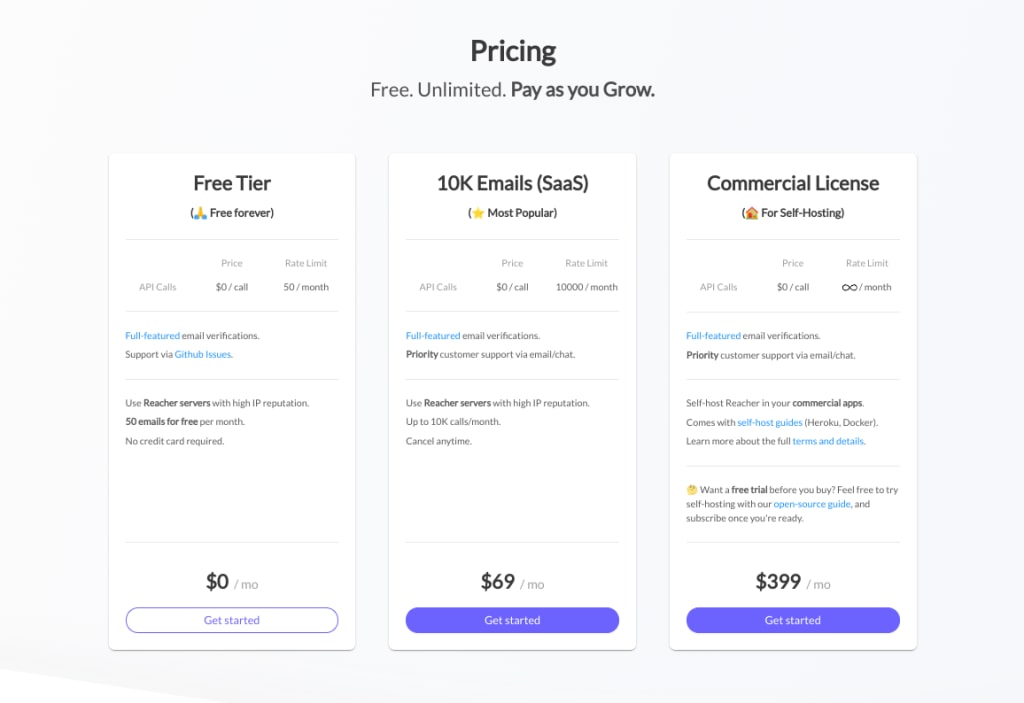
In the example above, we’ve got an example from email marketing software provider Reacher, which offers unlimited access to features with usage limits increasing on each plan.
This is a classic case of usage-based pricing and the only difference here is that the company describes it as a “pay as you grow” offer.
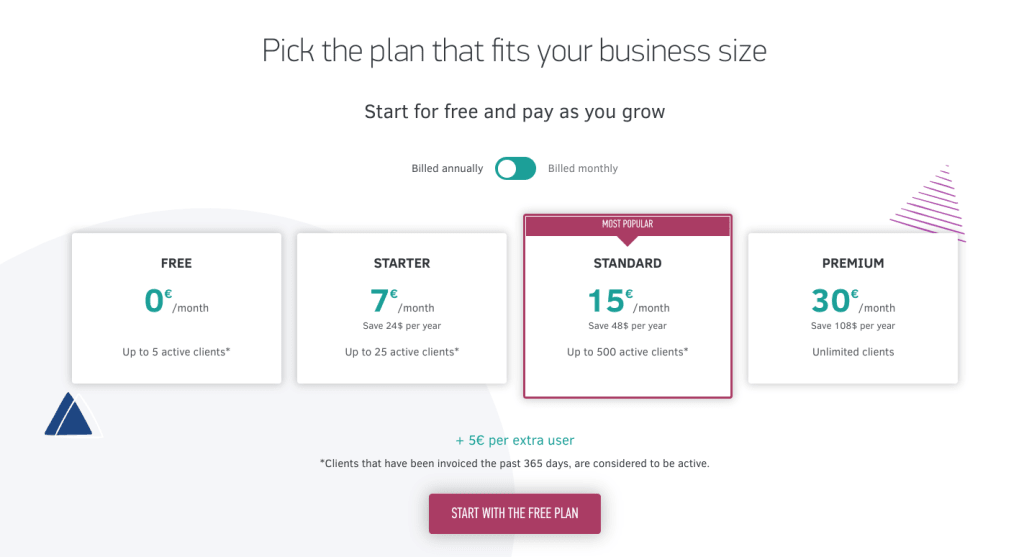
Elorus takes a similar approach but bases its pricing on how many clients its customers send invoicing to. This is similar to Unbounce’s pricing model that we looked at earlier, where it prices plans in relation to conversion rates.
In this case, Elorus aligns business growth with client volume and the value of its software increases as their customers have to send out more invoices every month.
Pros of pay-as-you-grow pricing
- Compelling message: The pay-as-you-grow angle justifies the expense of your product, communicates its value as a growth tool and lays out the upgrade path ahead of prospects.
- Value proposition: This message revolves around the promise that your product either drives or facilitates business growth.
- Clear upgrade path: The upgrade path is easy to communicate before prospects even sign up.
- Upgrade incentive: Customers align higher-tier plans with growth and success.
- Flexibility: You can combine usage-based pricing with other models and call it a pay-as-you-grow system.
The cons of pay-as-you-grow pricing
- Strategic complexity: Setting usage limits and feature restrictions to align with real business growth is difficult.
- Growth-price alignment: Growth numbers are worth more to some businesses and you can’t put a price on growth that suits everyone.
- Growth rate alignment: Different businesses grow at different rates so it’s difficult to hit the right price on each of your plans.
- Coverage: These pricing challenges typically lead to reduced market coverage.
- Optimisation: You have to invest time and money into optimising plans and pricing to find the best balance for the majority of your target customers.
The big issue with the pay-as-you-grow approach is that you have to set out the growth path for your target customers and nail the pricing on every plan.
For example, if you’re targeting small businesses with a product that’s designed to help them grow, this could work. Both Elorus (above) and EngageBay (earlier) do a decent job of this by offering affordable plans aimed at growing, smaller businesses.

However, you’re going to struggle to hit the right price points for smaller medium and larger businesses. This is probably why the pay-as-you-grow message is less popular than it once was and we now see companies like ActiveCampaign and HubSpot split pricing between features and usage to help them maximise coverage.
The one-time fee model
The one-time fee model predates cloud computing, license fees and every model we’re looking at in this article – something of a relic in the age of SaaS.
The simple fact is, subscription models generate more revenue over a longer period of time and lower the entry barriers for software adoption, allowing you to attract more customers and focus your efforts on keeping them signed up.
That said, the big downside most subscription models have in common is the complexity of plans and pricing. Some customers may appreciate the simplicity of paying a one-off fee or have the basic maths skills to understand they’re actually cheaper, long-term.
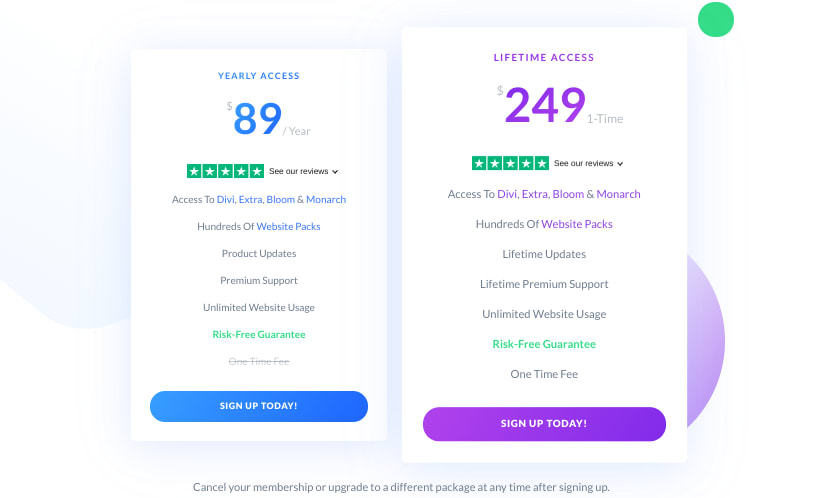
Either way, it’s not common to find SaaS companies using the one-time fee model but Elegant Themes is one of the exceptions. Customers can either pay an annual license fee or get lifetime access for less than 3X the price.
Best of all, customers paying the one-off fee get lifetime updates included so they’ll always be using the latest version of Elegant Themes’ platform.
Pros of one-time fees
- Simplicity: It doesn’t get any simpler than charging a one-time fee for a product.
- Affordability: In the long run, one-time fees are more affordable than monthly subscriptions.
- No contract: Customers aren’t locked into any contracts, cancellation fees or other complications.
The cons of one-time fees
- Short-term revenue: Subscription plans generate more revenue from customers in the long run.
- Unpredictable revenue: One-time fees make it difficult to predict and calculate revenue.
- No upgrade path: The one-time fee model doesn’t really work with plans or upgrades so there’s little chance of upselling.
- Initial cost: Although one-time fees are more affordable in the long run, the initial expense is much higher.
- Coverage: Higher initial prices reduce sales, especially among the high-volume small business or low budget customers.
- Growth limitation: High high entry barrier of one-time software fees limits growth.
The one-time fee model still deserves a mention in this article but it’s not really built for the modern age of cloud-based SaaS. There are clear benefits for the end user but few for the SaaS company trying to maximise growth and revenue while the higher up-front cost is an entry barrier for users on a budget.
As seen with Elegant Themes, the one-time fee approach can still work but it’s pretty much an archive model by this point.
SaaS pricing strategy examples
Your pricing model sets out the plans and upgrade path for customers but this is only one aspect of your pricing strategy. Behind the scenes, your pricing strategy considers customer needs, the current state of the market, your competitors and your business objectives – all of which evolve over time.
In this section, we look at the following seven pricing strategies most commonly used by SaaS companies:
- Penetration pricing: Undercutting the competition to build momentum.
- Cost-plus pricing: A simple pricing strategy for hitting revenue targets.
- Captive pricing: Winning customers with a limited product that requires paid features, add-ons or additional products.
- Price skimming: Setting a high initial price and gradually reducing it over time.
- Prestige pricing: Using high prices to maintain a premium image of your products.
- Value-based pricing: Charging prices based on the perceived value of your product.
- The 10x pricing rule: A rough guide for deciding what to initially charge for your SaaS product.
Value-based pricing is by far the most difficult of these strategies to pull off because it requires extensive market, customer and competitive research but it’s also, generally, the best strategy for SaaS companies, especially if you’re operating in a competitive area – and, let’s face it, all corners of the SaaS market become saturated with competition, sooner or later.
So, as a long-term pricing strategy, value-based pricing would have to be the top recommendation but some companies manage to drive early success with other strategies before adapting to their long-term goals.
Penetration pricing
Penetration pricing is commonly used by new companies in an established market, especially when it’s difficult to differentiate from the major players. or you’re trying to get people to do something different.
In this case, your best chance of grabbing attention (and customers) is competing on price and this is the key principle of penetration pricing.
This strategy involves lowering prices for the short-term, possibly to unsustainable levels, with the long-term goal of increasing prices after you’ve built a brand name and customer base to work with.
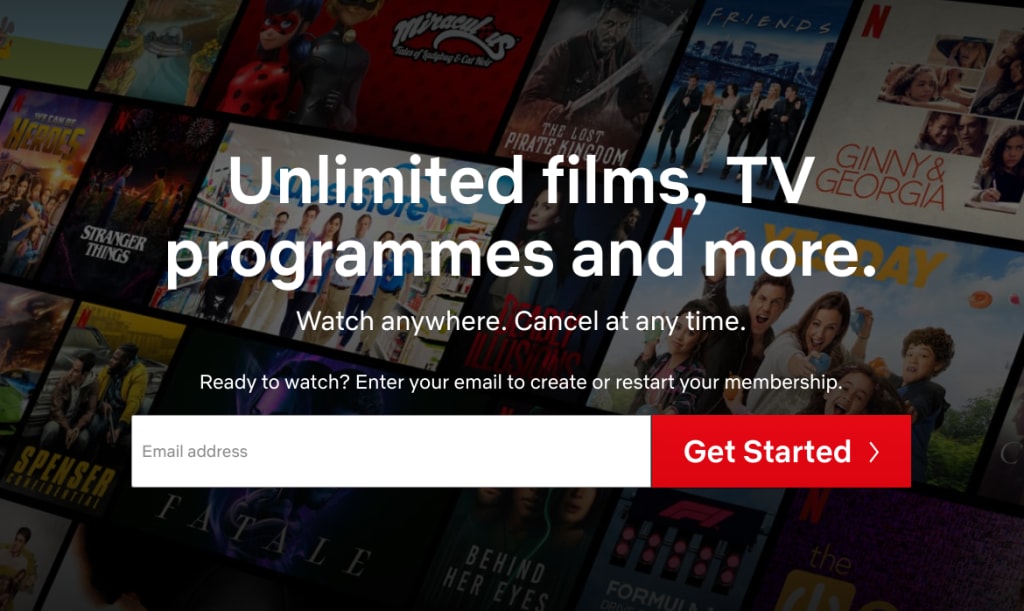
Netflix is one of the best examples of SaaS penetration marketing, entering the market in 2000 with its $15.95/month subscription plan that allowed customers to rent up to four DVDs at a time. That worked out at less than $1 per DVD for film fans when Blockbuster was charging $4.99 for a single, three-day rental.
At the time, Netflix wasn’t only taking on the biggest name in DVD rentals but also asking its customers to buy into an online subscription service. So the company also had to influence consumer behaviour quite drastically and it achieved this by severely undercutting the competition with penetration pricing.
Again, this was a short-term strategy designed to build the brand name and establish a customer base. Over the past 20+ years, the company has established itself as the market leader and routinely raises its prices to increase revenue.
Cost-plus pricing
Cost-plus pricing is a straightforward strategy that prioritises making more money than you spend. Otherwise called cost-based pricing, companies using this strategy typically define a target profit margin – for example, 25% – and set this as the basis of every business and marketing decision.
Here’s a basic formula for cost-plus pricing:
Cost-plus pricing = Customer Acquisition Cost (CAC) + Cost of Goods Sold (COGS) + Margin
So, let’s say it costs you $100 on average to win a new customer and your COGS (per customer) comes to $35. If your target profit margin is 25%, then your Cost-plus pricing formula is $100 + $35 + 25 = $160 so would set your fees at $160 to hit your target margin.
You can apply this formula to each plan of a SaaS product to determine a cost-plus price.
Generally speaking, this pricing strategy doesn’t have a lot (or any) consideration for competitor and market analysis, adaptive pricing or even the end user. It tends to focus purely on hitting your target profit margin and this goal informs every strategic decision.
Captive pricing
Captive pricing offers up a core product for a low or affordable price to attract customers and, then, charges extra key features or tools. This pricing strategy works well for SaaS companies offering free plans or cheap introductory plans for smaller businesses.
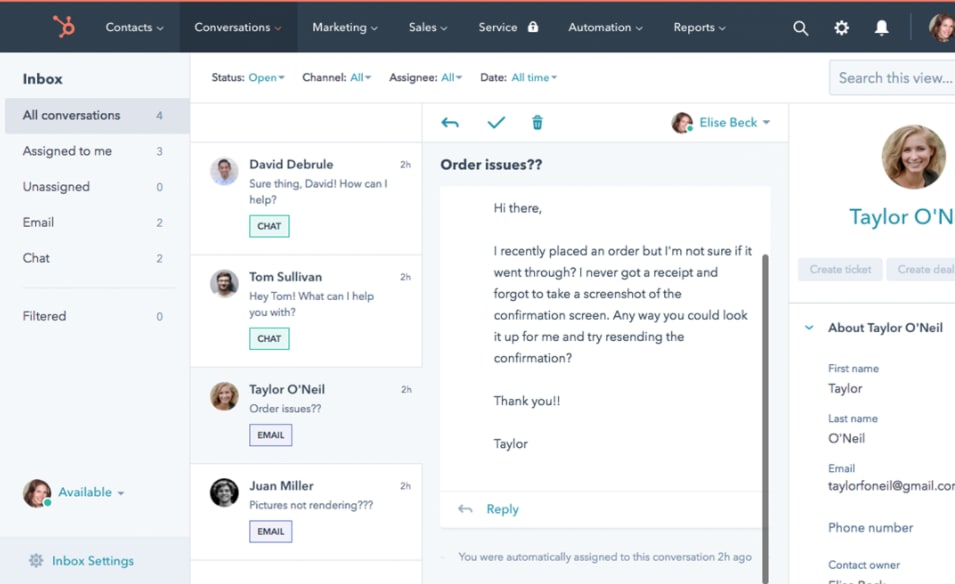
HubSpot is a great example of Captive pricing. The company offers one of the best CRMs around – for absolutely free – to attract customers. However, to get the best out of a CRM, you need to integrate sales and marketing software, which HubSpot just so happens to sell.
To bridge the upgrade path, HubSpot also offers free versions of its marketing and sales software but places usage restrictions on each plan to bump customers up to paid plans.
Price skimming
Price skimming is basically the opposite of captive pricing, where you set the highest price possible on your SaaS product at launch and gradually reduce your asking fees over time.
The idea is to maximise profit while your product is freshest and most appealing to your target audience while strategically lowering your price over time, typically to fend off competition or make your product appealing to a wider audience.
This strategy is great for innovative or unique products that don’t have any direct competitors.
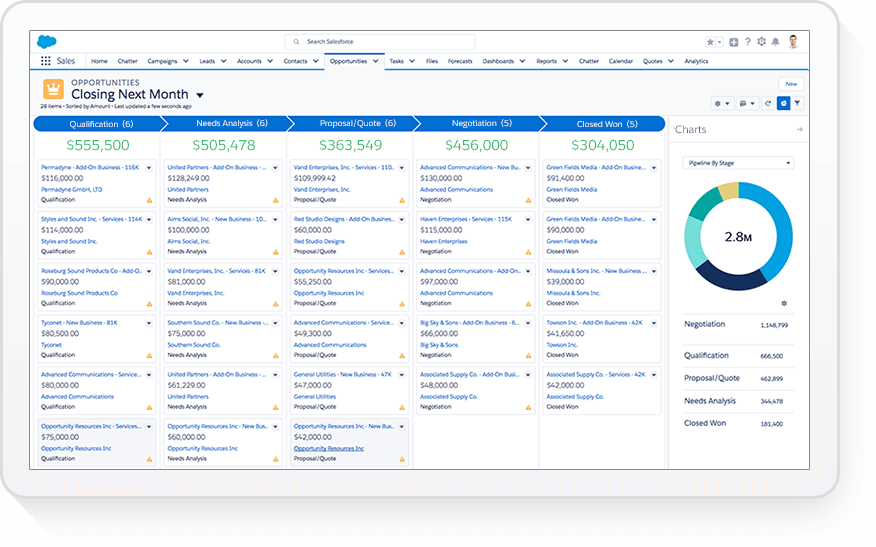
For example, Salesforce was the first company to release a CRM platform accessible to users 24/7 in the cloud. This was a radical product at the time and Salesforce was able to charge thousands per month to enterprise companies for an unrivalled product.
Over the past 20+ years, countless new SaaS companies have emerged with their own cloud CRM platforms, driving down prices and giving businesses more options to choose from.
Salesforce still has a strong brand name and it doesn’t need to compete with the cheapest CRM providers but it has needed to gradually reduce its prices and update its product to keep it relevant and competitive over a span of more than two decades.
Prestige pricing
Prestige pricing (or premium pricing) places a high price on products to position them as high-quality or desirable. Outside SaaS marketing, Apple might be the first example that comes to mind but this is common for sports car manufacturers, luxury fashion brands and most high-end products.
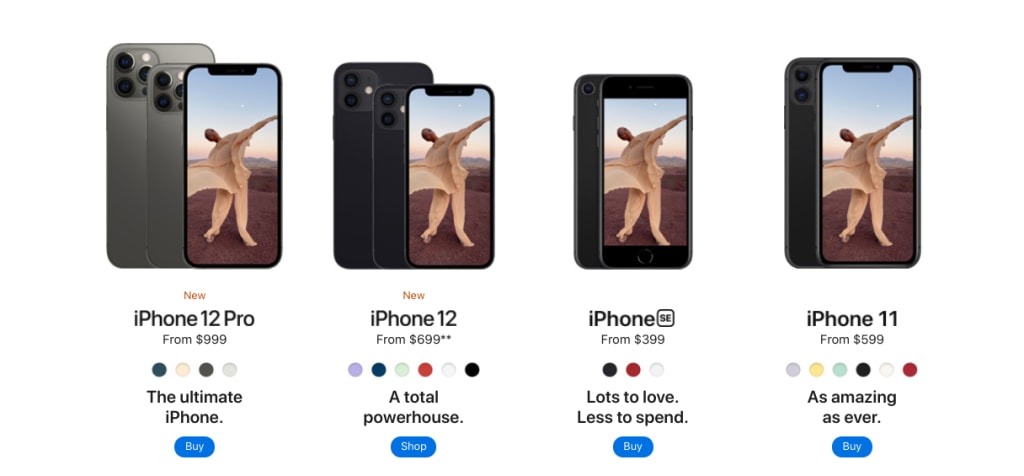
When consumer brands employ the prestige pricing strategy, brand image counts for a lot but this isn’t so much the case with SaaS products – it’s not as if users are wearing your logo.
However, you can drum up some of this brand excitement on social media by creating a community around your product and Semrush is a good example of this.
The company is always engaging with its customers, asking them questions and encouraging them to engage with each other – all around the product.
With Semrush’s business Business plan costing $449.95/month, I wouldn’t say this necessarily counts as prestige pricing but, the point here is, that SaaS companies can build brand hype, too.
In fact, prestige pricing isn’t a common strategy in the SaaS field and companies with expensive products typically don’t list pricing on their website.
As HubSpot illustrates, though, you don’t have to be a budget software provider to list your prices with pride.

HubSpot lists monthly fees for each of its plans but it also shows the total annual fee, which customers need to pay up-front. This isn’t common on SaaS pricing pages and HubSpot could easily leave this info out of the pricing details to make its products sound less expensive than they are (and they are expensive).
But HubSpot is proud of its reputation as an industry leader and it wants prospects to know its products are worth their asking price. So it goes fully transparent and says this is how much you’re going to pay, which is exactly what our existing customers are happily paying – because our products are that good.
Value-based pricing
Earlier, we looked at cost-plus pricing as the simplest strategy for software providers. Now, it’s time to discuss one of the most complex (but also most suitable) pricing strategies for SaaS companies: value-based pricing.
A value-based pricing strategy evaluates the target customers, current market and your product and/or services to determine the perceived value of your offering.
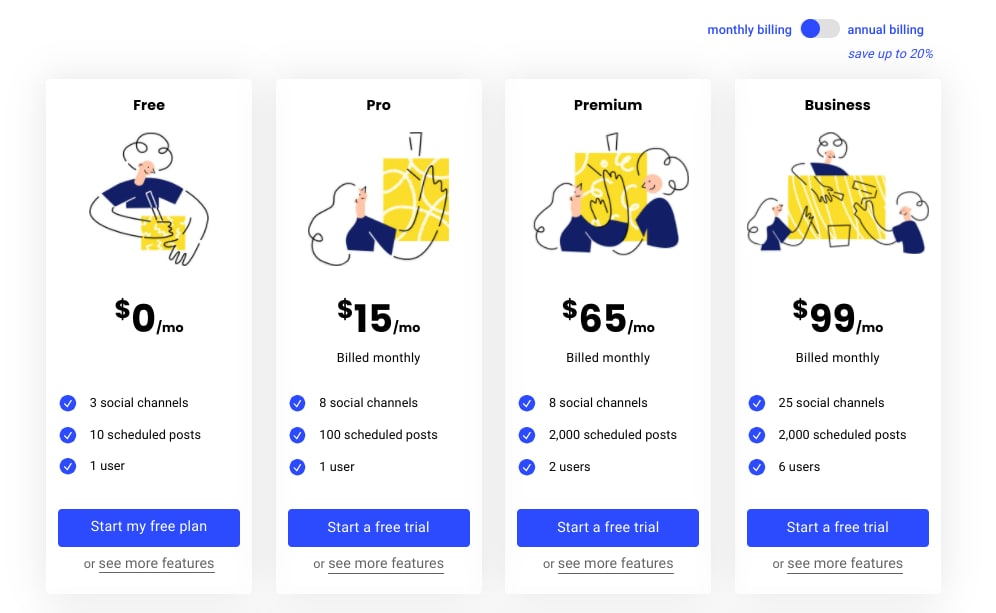
This strategy is particularly important for modern SaaS companies using tiered pricing and it goes hand-in-hand with the kind of research you have to conduct in order to decide what to include and exclude on each plan – and, ultimately, how much to charge for them.
Value-based pricing is a long-term strategy that requires extensive market, customer and product insights, which you have to compile on an ongoing basis.
This takes a lot of work but the constant stream of incoming data allows you to run experiments, test new pricing structures and strike the ideal balance between profit and growth for your business.
These insights also help you adapt your pricing strategy, model and fees over time, as the market changes. So, for example, you can determine the right time to lower or increase your monthly fees or introduce a lower-tier plan to cater for an emerging demand from micro-business owners.
This is how companies like Netflix decide when to increase their prices and by how much, knowing that they’ll lose some customers as a result but increase profits in the long run.
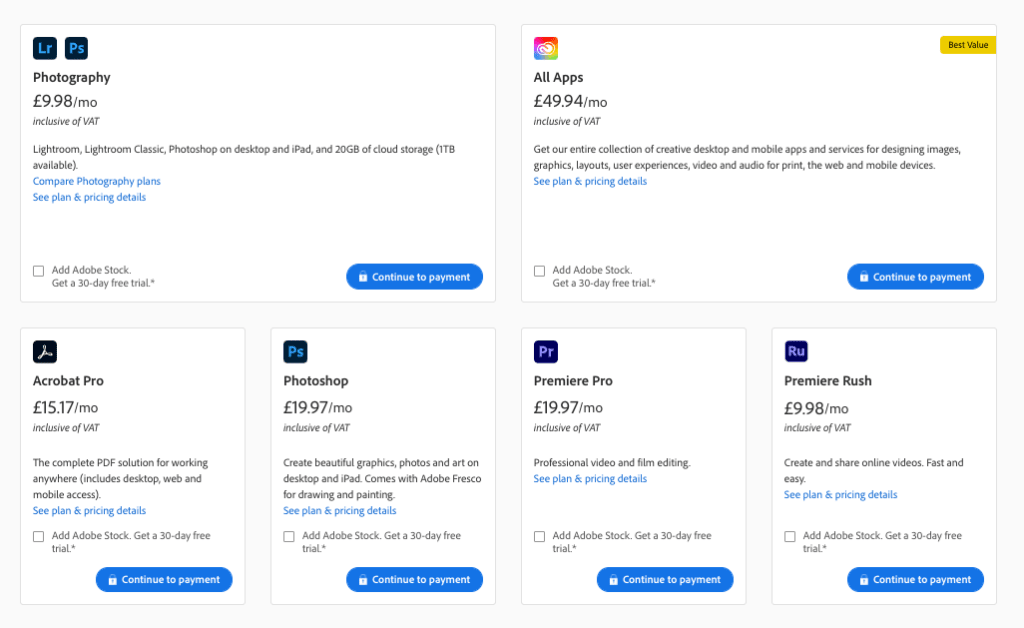
It’s also how companies like Adobe decide how to price individual software products and packages for different types of customers: creatives, professionals, businesses, students, teachers, etc. – and optimise these prices over time to maintain that balance of user numbers and revenue.
So, while this is a time and resource-heavy pricing strategy, it’s often considered the best approach because it forces you to take a data-driven approach and inform pricing decisions on insights.
The 10x pricing rule
The 10x rule was coined by Grant Cardone in his bestselling book, The 10x Rule: The Only Difference Between Success and Failure. While Cardone applies the rule to business, relationships, family and life in general, the concept has been adopted by many in the SaaS industry as a template for pricing software products.
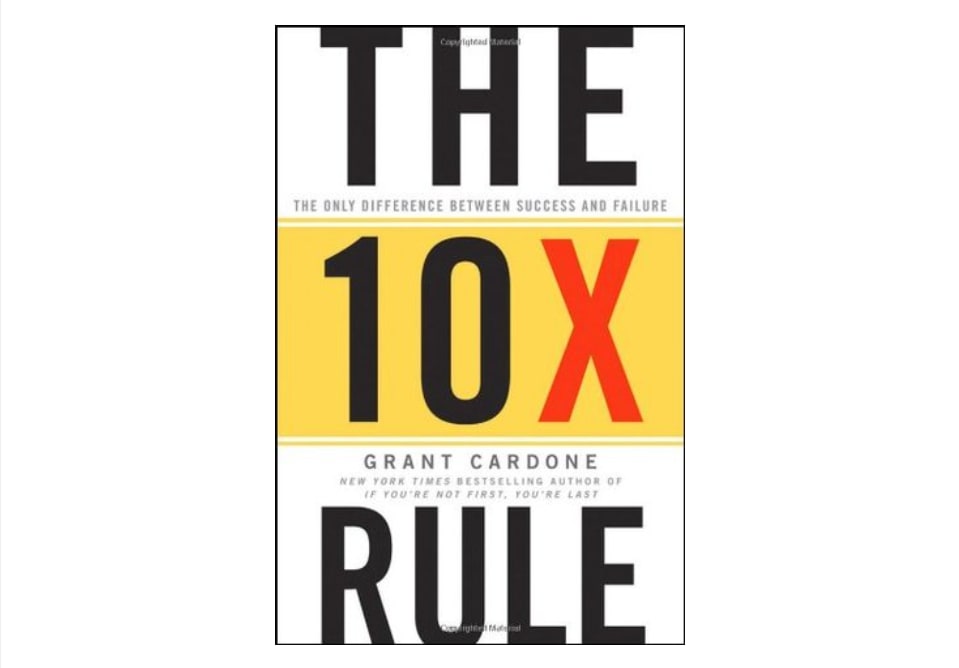
The theory itself is simple: The value your customers get from your software product should be 10x the price they pay.
So, if you charge $100/month for one of your plans, customers should make or save at least $1,000/month by using it – and recognise this value in order to justify the monthly expense.
Now, this is simply a theory and there are limitations, especially for products where value is difficult to define in numbers. For example, a company like HubSpot can calculate how much revenue its customers generate thanks to its software but how can Spotify quantify the value of listening to music in the age of free streaming?
The 10x rule is more suitable for B2B SaaS companies and it’s more of a principle than a “rule”. For example, if you’re pricing aggressively or using price skimming, you may start out charging significantly less or more than the 10x rule would suggest – and there’s nothing wrong with this.
You can always test against the 10x rule, later, when you adapt your pricing, change your plans or roll out new features.
Psychological pricing hacks for SaaS companies
Whichever pricing strategy and models you use, winning customers and holding onto them is all about one thing: value perception. And it really is the perception aspect that matters here.
The best strength you can have as a software provider is a product that delivers real value because this is what makes customers stick around. However, the quality of your software isn’t what turns pricing page visitors into customers.
It doesn’t matter how good your product is if you fail to understand the psychology of value perception. Here are some of the most common psychological hacks SaaS companies use to influence the perceived value of their products:
- Rounded numbers: Create the sense that your prices “feel right” and help visitors compare plan prices more easily.
- Price anchoring: How leading with your most expensive plan makes the rest feel affordable.
- Charm pricing: Exploit the “last digit effect” by setting prices that end with the number nine.
- Odd-even pricing: Control value perception by ending prices with odd or even numbers.
- Centre-stage effect: Place your most important plan in the middle of your pricing page.
- Limit options: Avoid choice paralysis by limiting the number of choices users have to make.
- Simplify differentiation: Reduce cognitive load by making the difference between plans simple and easy to understand/compare.
- Decoy pricing: Encourage users to choose a more expensive plan by offering an undesirable free or entry option.
With these psychological hacks, you can affect the way visitors perceive the value of your products and the expense of your prices.
Rounded numbers: Set prices that just ‘feel right’
The rounded numbers technique uses whole numbers without any decimal places and, crucially, rounded up to the nearest logical figure. So this involves prices like $25, $100 or $1,000 instead of prices like $19.99 or $199, which would be rounded up to $20 and $200 respectively.
This pricing technique works on two key principles, concluded in a 2015 research paper published by Oxford University Press. First of all, the study found that rounded prices make it easier for prospects to read, understand and compare prices, which is a help when users are comparing different pricing plans.
More importantly, the same study found that rounded numbers “lead to a subjective experience of “feeling right” when the purchase decision is driven by feelings”.
“This sense of feeling right resulting from the fit between the roundedness of the price number and the nature of decision context can make positive reactions toward the target product more positive and negative reactions more negative, a phenomenon referred to as the rounded price effect,” the abstract for the paper explains.
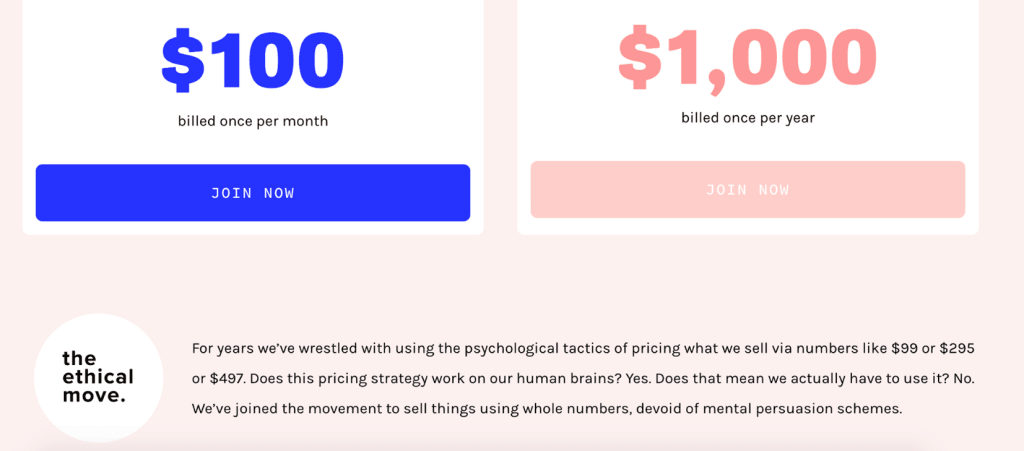
In other words, rounded pricing can enhance the positive or negative feeling prospects have about your product/offer when they visit your pricing page – ie: it enhances your marketing messages and page copy.
On a more primitive level, the simplicity of rounded pricing takes some of the emphasis away from your monthly fees and keeps your offer at the forefront.
There’s also an ethical case for using rounded pricing – a message promoted by the ethical move, which encourages companies to adopt rounded pricing as a more honest and transparent alternative to some of the more common pricing hacks.
Customers who are savvy to these pricing strategies may appreciate the honesty of rounded numbers, too. And there are other benefits to using rounded pricing, which we’ll explain in some of the other hacks in this section.
Price anchoring: Set the bar high to make your prices feel affordable
Price anchoring exploits a cognitive bias called anchoring bias where humans naturally place greater emphasis on the first piece of information they receive.
This first piece of information sets a precedent (or an anchor), which affects the perception of the information that follows it.
This means the first price someone sees on your pricing page sets the bar of perceived value and higher prices feel comparatively expensive while lower prices feel comparatively cheap.
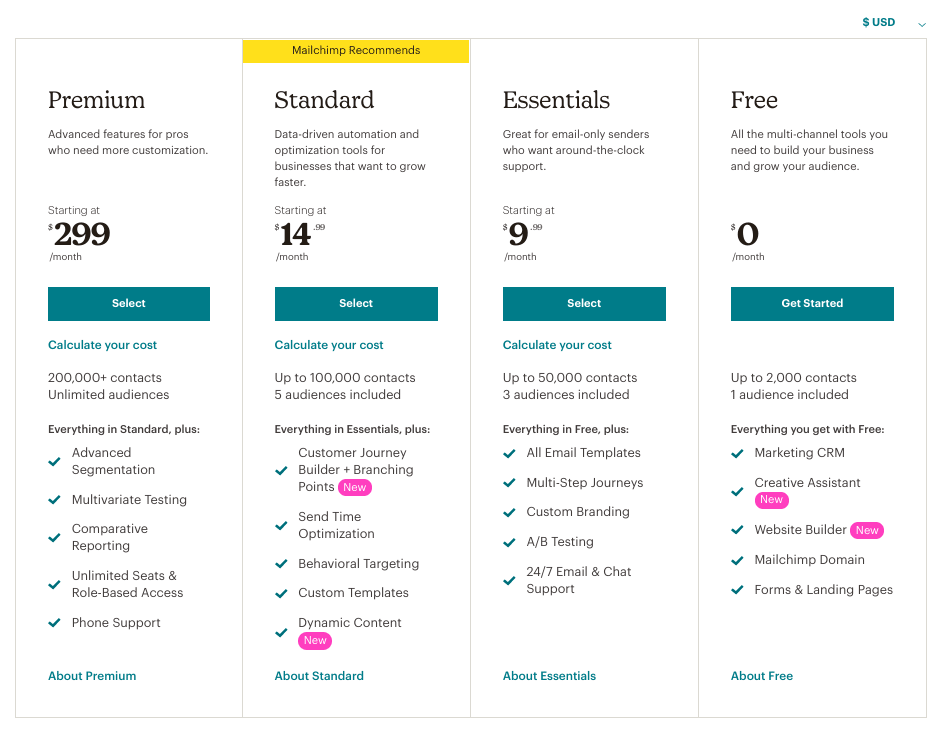
By leading with your most expensive plan, you set the bar at this price and your cheaper plans instantly look like a good deal.
In the example above, Mailchimp leads with its $299/month Premium plan, which dwarfs the asking price of the $14.99/month Standard plan, which almost feels insignificant after the bar is set by the Premium offering.
This sounds crazy (and it is) but think about it: if someone finds a software product that costs $50/month, then that doesn’t sound particularly affordable in a world filled with free apps, freemium software and cheaper alternatives.
On the other hand, if they find a product that costs $500/month and then see a cheaper plan offering most of the same features for $50/month, the same price instantly sounds like good value.
If Mailchimp led with its free plan, the $14.99/month Standard pricing would come across as relatively expensive, following the free and $9.99 Essentials plan but the use of anchoring bias here creates the opposite effect and compels users to choose the Standard plan.
Charm pricing: The power of prices ending with the number nine
Charm pricing is the most common pricing hack, used by companies across every industry. It exploits the “left digit effect” by ending prices with the number nine, dropping the first number of the price down to the previous number – e.g.: $300 becomes $299.
Mailchimp actually uses this tactic on the pricing of its Premium plan, which is priced at $299 instead of $300, which instinctively sounds cheaper.

Decades of research have gone into testing this cognitive bias and the results continue to show the effectiveness of charm pricing, even though we all know we’re being tricked – the left digit effect is that powerful.
In William Poundstone’s famous 2010 study, Priceless: The Myth of Fair Value, charm pricing outsold rounded prices by 24%. Even more remarkable, is the infamous 2003 MIT study, in which customers chose items priced at $39 over the same ones priced at $44 (no surprise) and the cheaper price of $34.
This suggests the power of charm pricing is bigger than the left digit effect and simply setting prices with the number nine as the final digit conveys a sense of value.
Odd-even pricing: Setting the last digit changes everything
Sticking with the theme of setting the last digit in your prices, you’ve also got the dual hack of odd-even pricing. This collective tactic uses one of two techniques: odd pricing, where the last digit of your fees is an odd number (other than nine), and even pricing, where the final digit is an even number.
While charm pricing continues to be effective, it’s so common that the psychological impact can be reduced if users are desensitised to seeing it so often that the left digit effect fails.
Odd-even pricing breaks the repetition of charm pricing and this forces the user to pay more attention to the figure in front of them.
Here’s an example from Sendinblue, which uses odd pricing on its Lite and Premium plans:
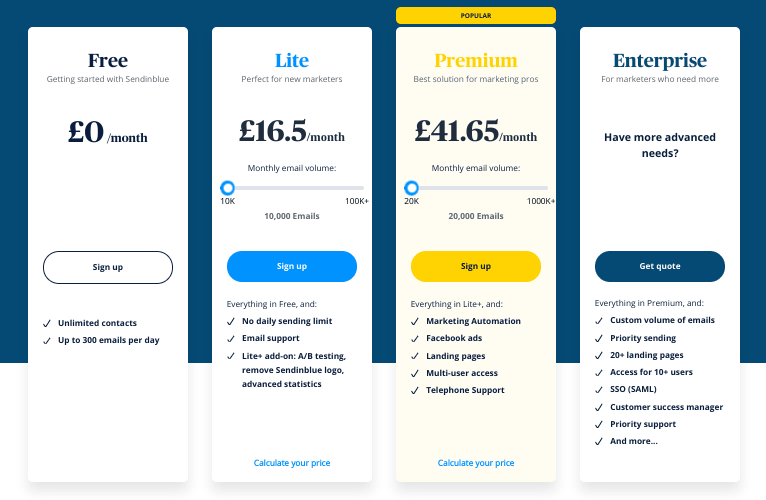
This is an effective technique if you want to highlight the price of your products – for example, if you’re cheaper than the competition.
You don’t have to use decimal either with odd-even pricing. Here’s a look at the pricing page for Wix premium plans:

So we’ve got some price anchoring going on here and Wix also uses a mix of odd-even pricing, which is most evident on its VIP and Unlimited plans which are priced at $18/month and $8.50/month where you might normally expect to see prices of $19/month and $9/month.
Earlier, we looked at rounded numbers and, technically speaking, these are a form of even pricing. So, in this instance, Wix’s VIP and Unlimited plans would be priced at $20/month and $10/month.
Centre-stage effect: Exploit people’s natural tendency to take the middle ground
The centre-stage effect describes why people comparing a range of similar products tend to choose one from the middle of the selection. So, if you’re offering three software plans, there’s a natural bias towards choosing the plan in the middle.
You can enhance this phenomenon with strategic pricing, too, by exploiting people’s natural resistance to the most expensive and cheapest options available to them.
Buyers want to feel like they’re getting a good deal but they also want to feel like they’re getting quality in return for their money. As mentioned above, it’s all about perception with high prices promoting a sense of quality and lower prices being associated with lower quality.
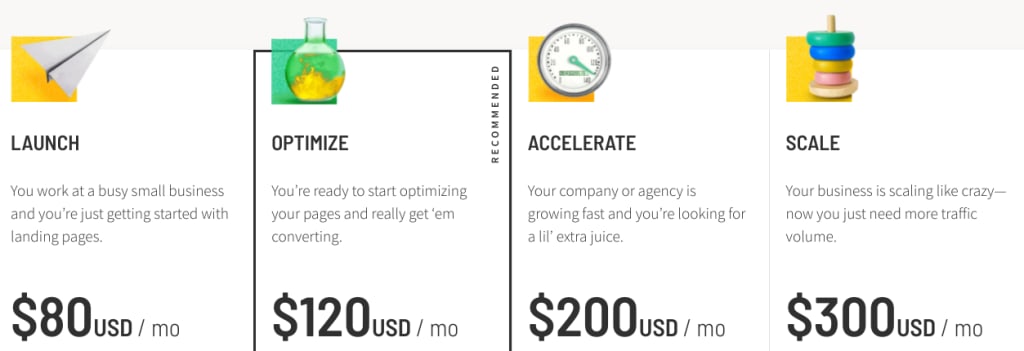
The screenshot above shows part of the Unbounce pricing page and, like many SaaS companies, it uses the centre-stage effect to promote its most important plan.
It doesn’t make any secret about this, either: it even sticks a “recommended” label on the Optimize plan and you’ll often see this kind of label added to centre-staged plans.
If we go back to the Mailchimp example we looked at earlier, there’s another recommendation label on the second plan.

However, Mailchimp is enhancing the impact of the centre-stage effect by combining it with anchor pricing, meaning its second most expensive plan becomes the natural choice for buyers who want quality and value.
This is enhanced even further by the disparity of the pricing between the Premium plan and other plans. The difference between $299 and $14.99 is huge but the difference between $9.99 and $14.99 is relatively small.
So, assuming the anchor pricing works here, users are subconsciously buying into a $300/month platform for $14.99/month.
Limit options: Prevent choice paralysis from killing conversions
Choice paralysis is the cognitive outcome of people being overwhelmed by options to the point where they make no decision at all. Hick’s law describes how the time it takes for a person to make a decision increases as the number of options available to them increases.
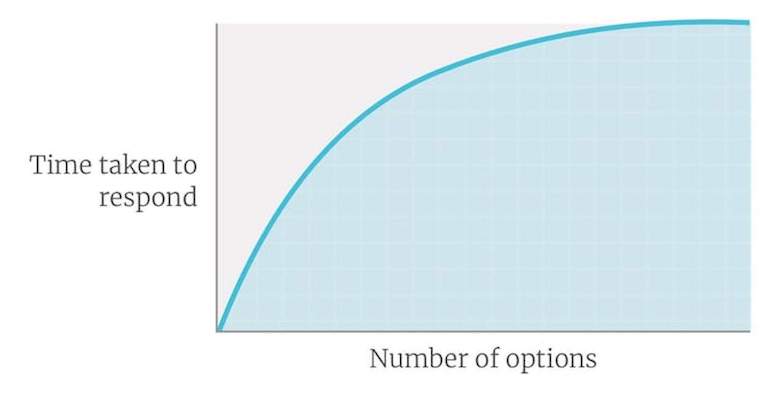
You think about this from a SaaS perspective and it makes a lot of sense. The more plans, prices and features a prospect needs to consider, the more difficult it becomes to make a choice and the easiest outcome for the user is quitting the session without making any decision.
Decision fatigue is another factor worth understanding here. This describes the increased difficulty of making decisions and the lower quality of the decisions made when the mind is forced to make multiple decisions or difficult decisions in a short period of time.
In other words, if you spend all morning racking your brains about how to price your SaaS product, your brain is too fried to choose what to have for lunch and you end up buying that weird egg salad sandwich you don’t even like.
Now, imagine a user who has looked at five SaaS websites before they land on yours. They’ve exhausted all of that energy trying to decide whether those products with multiple plans, different features sets and price points are right for them.
So what are they going to do when they look at your pricing page and see five different plans with page-long lists of features and variable prices?

Chances are, anyone who views your pricing page is looking at several other providers and there’s a good chance they’re feeling overwhelmed by all of the options available to them.
Shopify helps users make decisions by offering three plans that are clearly designed for different business types. Three really is the magic number when it comes to easing the cognitive load on visitors, especially if you can clearly define the differences between each plan (see the next section) without forcing visitors to scroll through lists of features.
As mentioned earlier, complexity is the biggest disadvantage of tiered pricing but this is a challenge you have to overcome if you want to target multiple customer profiles – e.g.: different business sizes.
Of course, there are alternative pricing models and we discussed flat-rate pricing at the beginning of this article, which removes choice paralysis and decision fatigue from the equation.
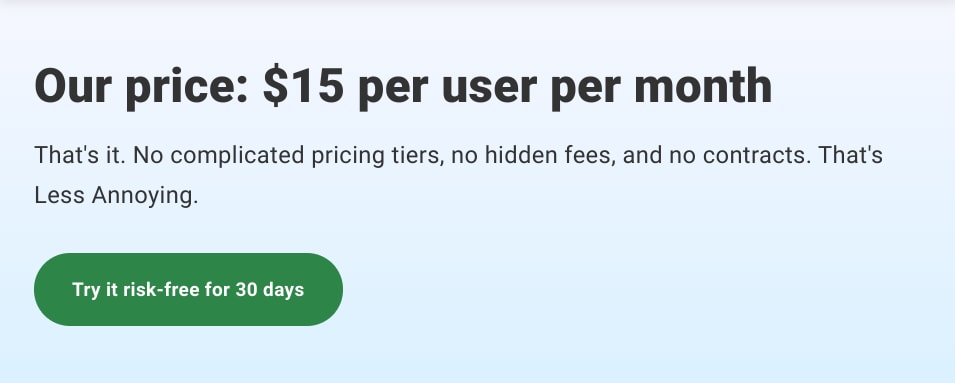
Less Annoying CRM charges a flat rate of $15/month per user with no plans, pricing tiers, hidden fees or contracts. Prospects either buy into the platform or they don’t and the decision couldn’t be much easier.
We see a similar strategy from Basecamp, which charges a flat rate of $99/month for unlimited users and projects. So, instead of asking users to compare plans and feature lists, Basecamp can focus on comparing the benefits of its product against the competition.
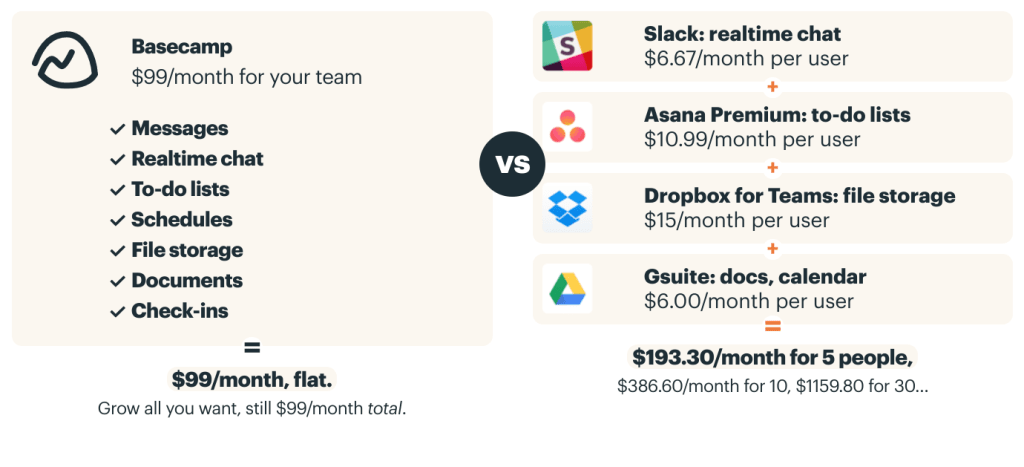
Basecamp’s key selling point is the price saving compared to paying for several other apps and the simplicity of having one tool that does multiple jobs without switching between products.
This simplicity is matched but he flat-rate pricing, which emphasises the products message and key differentiator in a competitive space filled with rival SaaS products.
Simplify differentiation: Make choices easier by clarifying differences
Another way to make choices easier for prospects is to simplify the differentiation between your plans. If users have to scroll through feature lists to understand what separates your plans, you probably haven’t made this clear enough in your page copy.

Earlier, we looked at how Shopify makes choices easier by running three plans but it also clearly states which type of customer each one is aimed at. This leaves no confusion for the end user and this is important for Shopify because the feature differences between plans aren’t that significant.
We see a similar approach from Canva, which offers paid plans for professional designers and businesses alongside its free plan.
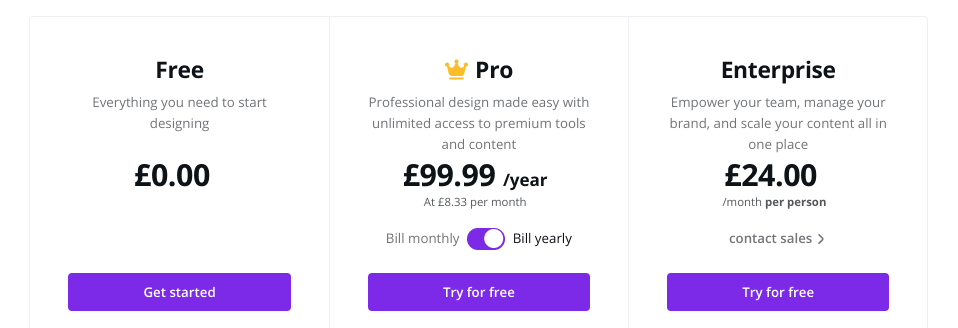
Again, the feature differences between each plan are quite small but important for each target audience. However, it doesn’t assume people know what they need from the platform and expect them to scroll through feature lists to determine which plan is for them.
Instead, it clearly differentiates its plans to point users in the right direction, as soon as they land on the pricing page.
If you’re not targeting multiple customers types but simply different businesses sizes, then you may have to communicate differentiation more clearly with features or limitations.
For example, Typeform lists the limitations of each plan at the top of the feature summary on its pricing page. Visitors can see how many responses they can get on each plan, how many users are covered and the key feature differentiations to help them choose the right plan.
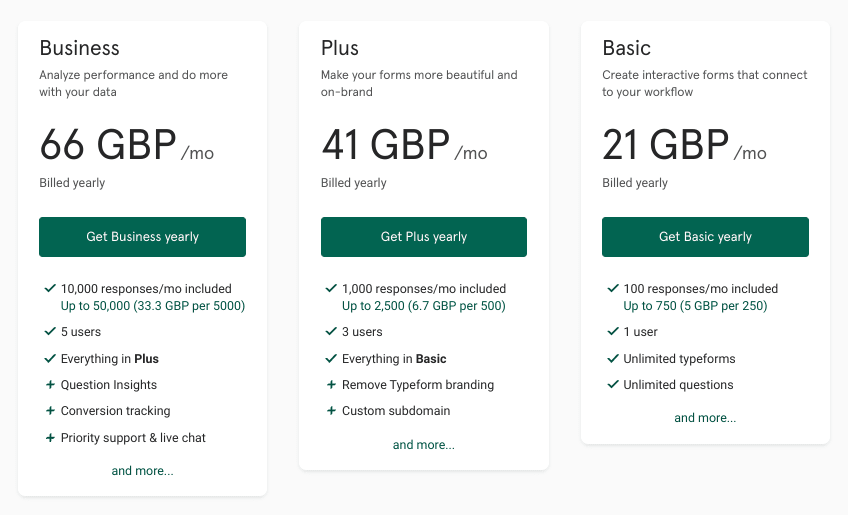
If someone wants to use Typeform and they’re receiving 30,000+ email responses every month, then it’s clear they need to sign up for the business plan to cover their existing needs.
This kind of feature separation is crucial for quickly conveying the difference between plans, especially if you’re targeting different business sizes rather than different customer types – e.g.: professionals, agencies, etc.
Decoy pricing: Offer a dud plan to upsell on the first purchase
Decoy pricing is a tactic used to coerce users into signing up for a particular plan. Basically, you offer one plan that’s priced disproportionately low or restricted in features to the extent it’s never really an option for your target customer base.
So, instead of covering the full spectrum of needs, you’re encouraging users who might sign up to a lower plan to jump straight to a more expensive option by not providing a mid-point.
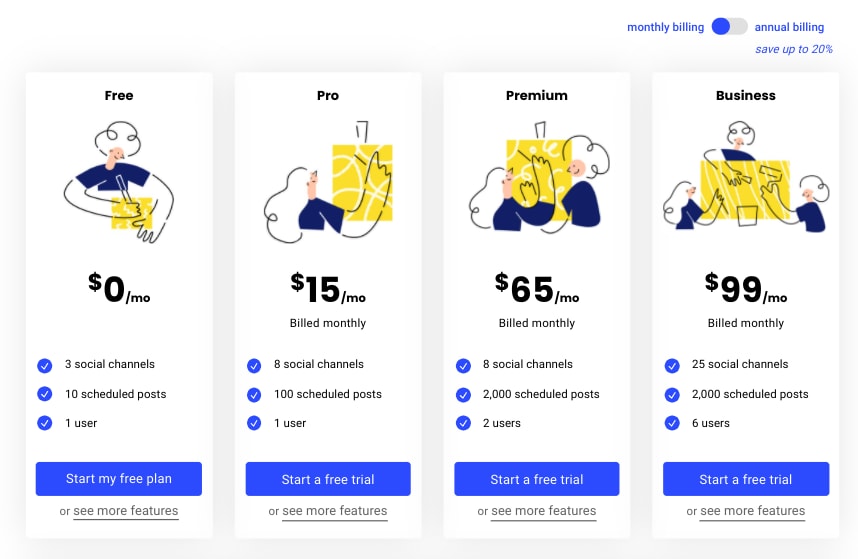
If you take a look at Buffer’s pricing page, the Free and “Pro” plans are so heavily restricted that they’re basically useless to any marketer or business. For $15/month, you’re limited to scheduling just 100 posts across eight channels, which isn’t much use to any company that wants a social automation tool like Buffer.
So the vast majority of paying Buffer users are forced to sign up to the $65/month Premium plan or the $99/month Business plan before they can schedule more than 100 posts every month.
By leaving gaps in your plans and pricing, you can force users to sign up for more than they need – a risky strategy if you’ve got competitors willing to satisfy your customers at cheaper rates but a valid strategy increasing revenue and customer value.
How to choose the right pricing strategy for your SaaS company
Most SaaS companies run with a value-based pricing strategy with a combination of pricing models worked into a tiered system. There’s no magic formula for SaaS pricing and finding the right strategy is a long-term process of experimentation and learning.
The truth is, you don’t choose a winning pricing strategy; you discover one by testing different strategies with real users while optimising your pages to maximise conversions and retaining existing customers.
The trickiest part is isolating tests so that you can attribute results to changes in your pricing strategy without getting them confused with CRO experiments, for example.
This experimentation process takes years, not months and your pricing strategy will change over time as your company grows and your business goals become more ambitious. And, even once you settle on a pricing strategy, there are plenty of tweaks you can test, including some of the psychological hacks we looked at in the last section.
Turn your SaaS pricing strategy into a business asset
An effective pricing strategy wins customers, drives growth and hits revenue targets. As mentioned in the introduction of this article, pricing is the most important strategic aspect of a SaaS product and everything falls apart if you get this wrong.
SaaS pricing isn’t a set-it-and-forget-it decision, either. It’s an ongoing process of optimisation and experimentation.
As your business goals change, the needs of your target customers evolve and market trends change your competitive position, your pricing strategy needs to adapt and maintain that all-important balance between customer acquisition, customer retention and revenue.
If your SaaS pricing strategy isn’t one of your strongest business assets, now is the time to start rethinking it.



